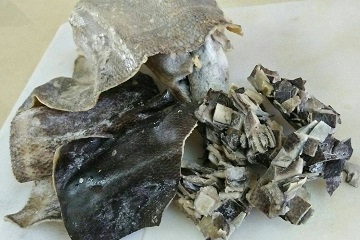IPB Students Utilize Tuna Fish Waste for Halal Capsules

Research innovation in the pharmaceutical field is increasingly varied. Most innovations are used to facilitate humans in the treatment of the disease or create an alternative material when the main ingredients are limited. One of them is halal capsule from gelatin found by Bogor Agricultural University (IPB) student.
Three students from the Faculty of Fisheries and Marine Sciences (FPIK) IPB, Rika Puspita, Mega Bintang and Shafa Sandida channeled the idea of the halal capsule through Research Student Creativity Program (PKM-PE) entitled "Kapalgena: Halal Capsule of Skin Gelatin Tuna Fish as Application in Biomedical ". This innovation is under the guidance of FPIK lecturers IPB namely Dr. Mala Nurilmala, S.Pi., M.Si
"Actually for the manufacture of capsules themselves can use other materials such as carrageenan. But the carrageenan capsule needs a longer time to be destroyed, therefore our team tried to make capsules with gelatin material from tuna skin, "said Rika as Chairman of PKM Kapalgena Team.
The use of tuna skin for gelatin production is due to the high production of tuna in Indonesia, both fresh and processed. The high value of production resulted in increased processed waste so that the manufacture of gelatin from tuna skin becomes one of the solutions for the reduction of waste.
"Besides reducing the processed waste of tuna fish, the benefits of making these halal capsules as well as forms of pharmaceutical preparations that do not cause problems in the community. Because, a capsule which is made of gelatin from cattle and pigs cause a problem for the community, especially in Indonesia, "added Rika.
Preparation of gelatin begins with cleansing the skin of tuna from the rest of the meat and fat to further cut into small pieces and washed. After preparation, the skin is hydrolyzed by the acid method and extracted by the hydrothermal method. Extraction results in the form of liquid will be dried with an evaporator to dry gelatin. The dry gelatin is diluted and continues to be molded and dried. The final stage after drying is the capsule removed from the mold and can be filled with medicine or vitamins.
"In the preparation of gelatin, hydrolysis is usually carried out by the alkaline method or acid-base method. The difference with this gelatin study, we use acid hydrolysis alone. In addition, research on capsules from fish skin is still not much, "he continued.
With a study time of approximately three months, the Kapalgena Team also experienced several obstacles in the study such as experiments in obtaining proper gelatin proportions to the determination of the concentration of gelatin solution in the manufacture of capsules. Even so, Rika and her team hope with the research can be the latest innovation in the field of pharmacy.
"Hopefully, in the future, this research can be used as reference material or reference for companies that will develop gelatin in Indonesia especially from raw materials of fish," said Rika. (flw)



